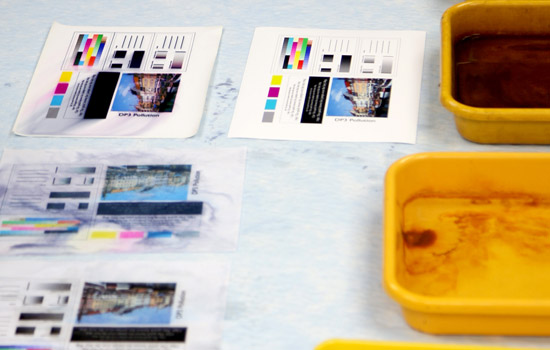Image Permanence Institute receives $240,922 grant
Research aimed at disaster prevention best practices for inkjet prints in museum collections
Various inkjet prints being tested for water fastness. RIT’s Image Permanence Institute has received a National Leadership Grant award to help in the creation of disaster prevention response and recovery plans for modern inkjet prints in museum collections.
The Image Permanence Institute at Rochester Institute of Technology has received a National Leadership Grant award of $240,922 from the Institute of Museum and Library Services to help in the creation of disaster prevention response and recovery plans for modern inkjet prints in museum collections.
Despite the large numbers of inkjet-printed documents, photographs, and other art materials within museum collections, museum personnel are typically unaware of the makeup of inkjet materials or how to care for them—including how to prevent or respond to damage caused by natural disasters such as floods or other unintended exposures to water.
“Many inkjet prints are considerably more sensitive to water damage than traditional prints,” says Daniel M. Burge, a senior research scientist at the Image Permanence Institute. “IPI has a long-term commitment to research and education regarding the materials and techniques behind the printed image. This two-year project is designed to help museums develop best practices to help in the recovery and preservation of modern inkjet prints in their collections.”
According to Burge, existing research suggests that inkjet prints are prone to high levels of dye bleed, cracking and other damage. While IPI has completed preliminary research has been done to rank the relative sensitivities of these materials, a full understanding of how the materials will behave during different water damage scenarios—from prolonged full immersion to small spills, as well as exposure to sustained damp or humid conditions—has yet to be performed.
“This project is designed to fill that knowledge gap and provide museum personnel with the information and tools they need—first, to minimize risk of damage; second, to respond most efficiently during the event; and third, to retrieve and stabilize exposed materials following such events,” Burge says.
He notes that with climate change resulting in a greater number and more severe natural disasters such as Hurricane Sandy a year ago, “this research is as timely as ever.”
The competitive grants, made possible through the Institute of Museum and Library Services, are part of its National Leadership Grants program. The IMLS is the primary source of federal support for the nation’s 123,000 libraries and 17,500 museums.
The National Leadership Grants for Museums program supports projects that address critical needs in the museum field that have the potential to advance best practices in the profession and improve services for the American public.
The grants were announced by Rep. Louise M. Slaughter (D-Fairport), co-chair of the Congressional Arts Caucus. Slaughter says IPI’s grant is a testament to the institute’s ongoing commitment to care for treasured collections.
“I’m delighted to support the work of RIT’s Image Permanence Institute,” says Slaughter. “IPI’s work gives us a great sense of security knowing that our most treasured printed documents and photographs—and the culture and history they contain—will be protected if disaster strikes.”
IMLS museum grantees will be recognized in a ceremony on Capitol Hill on Sept. 18.
About The Image Permanence Institute
The Image Permanence Institute, part of RIT’s College of Imaging Arts and Sciences, is a recognized world leader in the development and deployment of sustainable practices for the preservation of images and cultural property. The institute accomplishes this through a balanced program of research, education, products and services that meet the needs of individuals, companies and institutions.













